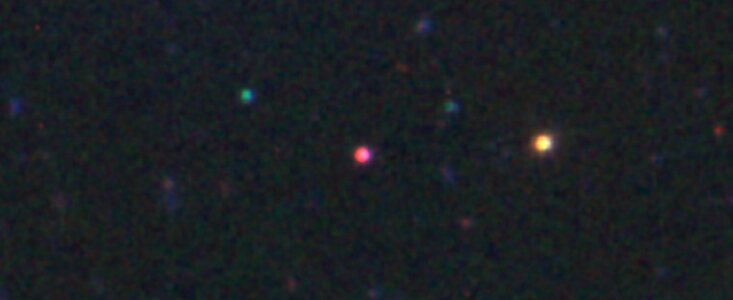Celestial Fireworks Flare as Massive Black Hole Consumes Star in Distant Galaxy
16 Junio 2011
An international team of astronomers using the Gemini North telescope revealed that a powerful outburst of radiation originated from a massive black hole at the center of a distant galaxy. The black hole, thought to be about a million times more massive than our Sun, appears to have ripped apart a star that orbited too close and in the process released a powerful beam of energy. The light emitted by the beam crossed 3.8 billion light years of space to be eventually detected by NASA’s Swift satellite. This triggered a flurry of activity by an international team of astronomers who rushed to make detailed observations of this remarkable event with Gemini and other telescopes.
Their research is published today in two companion papers in the June 16, 2011 issue of the journal Science.
“The high energy X-rays and gamma-rays detected by Swift persisted at an extremely bright level for weeks after the event,” said Dr. Andrew Levan of the University of Warwick (UK) who led the complex observational campaign and is the first author on one of the papers. “Bright flares arose when further chunks of the star apparently fell into the black hole, while at optical and infrared wavelengths the consumption of this star was as bright as a hundred billion suns.” Levan also explains that the extreme brightness of this particular event as seen from the Earth is thought to be because the bulk of the energy was focused into a beam pointing toward the Earth. “Despite the power of this cataclysmic event we still only happen to see this event because our solar system happenens to be looking right down the barrel of this jet of energy."
The new research clearly establishes that the source of this event (known now as Swift 1644+57) is right at the heart of a galaxy 3.8 billion light years away, in the direction of the northern constellation Draco. This distance, first measured with the Gemini North telescope, meant that the outburst was more powerful than any known quasar. The conclusion that the extreme energy generated is caused by the tidal disruption of a star by the massive black hole at the core of this galaxy is from a model put forward in the second Science paper, led by Josh Bloom, an associate professor at the University of California, Berkeley.
"This burst produced a tremendous amount of energy over a fairly long period of time, and the event is still going on more than two and a half months later," said Bloom. "That's because as the black hole rips the star apart, the mass swirls around like water going down a drain, and this swirling process releases a lot of energy."
Professor Nial Tanvir, team member from the University of Leicester added "It is rare for stars to get very close to the black holes in the centers of galaxies, but when they do, they will always come off second best."
Research Credits:
The researchers used an array of telescopes to study Swift 1644+57, including Hubble Space Telescope, Swift satellite, the Chandra X-ray Observatory, the Gemini Observatory and the United Kingdom Infrared Telescope to study the blast. Swift's Burst Alert Telescope first discovered the source, on March 28, when it erupted with the first in a series of X-ray blasts.
UK involvement in Swift is supported by the UK Space Agency. The Gemini Observatory, UKIRT (United Kindgom Infrared Telescope) and WHT (William Herschel Telescope) are supported by the Science and Technology Facilities Council in the UK.
Prof Josh Bloom, of the University of California, Berkeley, led a second paper, published simultaneously in Science in collaboration with this work, and entitled "A relativistic jetted outburst from a massive black hole fed by a tidally disrupted star".
Home Page Banner Image Credit: University of Warwick/Mark A Garlick.


